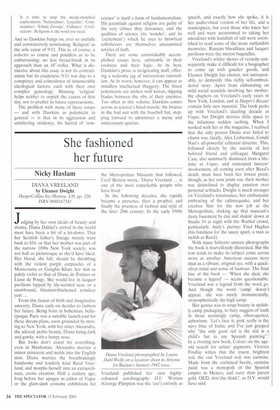She fashioned her future
Nicky Haslam
DIANA VREELAND by Eleanor Dwight HamerCollins Inc/Morrow, £30, pp. 320, ISBN 0688167381 Jrudging by her own ideals of beauty and drama. Diana Dalziel's arrival in the world must have been a bit of a let-down. That her Scottish father's lineage merely went back to 834, or that her mother was part of the narrow 1890s New York society, was not half as picturesque as she'd have liked. Her blood, she felt, should be throbbing with the violent purple corpuscles of a Montezuma or Genghis Khan, her skin as palely violet as that of Diane de Poitiers or Liane de Pougy. She would live in lacquer pavilions lapped by lily-scented seas, or a snowbound, bitumen-blackened reindeer yurt ...
From this fusion of birth and imaginative ancestry, Diana early on decides to fashion her future. Being born in bohemian, belleépoque Paris was a suitable launch-pad for these dream-plans, soon grounded by moving to New York, with her sister Alexandra, the adored, petite beauty, Diana being dark and gawky. with a lumpy nose.
But looks don't count for everything, even in Manhattan. Alexandra marries a minor aristocrat and melds into the English mist. Diana marries the breathtakingly handsome and tenderly kind Reed Vreeland, and morphs herself into an extraordinary, exotic creation. Half a century ago, long before her apogee as editor of Vogue or the glam-slam costume exhibitions for the Metropolitan Museum that followed, Cecil Beaton wrote, 'Diana Vreeland ... is one of the most remarkable people who have lived.'
In the following decades, she rapidly became a presence, then a prophet, and finally the priestess of fashion and style of the later 20th century. In the early 1980s Vreeland published her own highlycoloured autobiography D.V. Written (George Plimpton was the 'ear') entirely as
speech, and exactly how she spoke, it is her audio-visual version of her life, and a masterpiece, but even those who knew her well and were accustomed to taking her anecdotes with handfuls of salt were astonished to read some of the more outlandish memories. Russian bloodlines and lacquer pavilions were the merest bagatelles.
Vreeland's wilder shores of veracity consequently make it difficult for a biographer to come up with gaudier goods, and Eleanor Dwight has chosen, not unreasonably, to demystify this richly self-embroidered story. Apart from elaborating on mild social scandals involving her mother, the chapters on Vreeland's early years in New York, London, and at lialper's Bazaar contain little new material. The book perks up with Vreeland's dazzling decade at Vogue, but Dwight devotes little space to the infamous sudden sacking. When I worked with her at the magazine, I realised that the only person Diana ever failed to charm was, fatally, Alex Lieberman, Conde Nast's all-powerful editorial director, This, followed closely by the suicide of her beloved friend and colleague Margaret Case, also summarily dismissed from a lifetime at Vogue, and rumoured lawyers' involvement, all coming soon after Reed's death, must have been her lowest point, though, as her sons point out, their mother was disinclined to display emotion over personal setbacks. Dwight is much stronger on Vreeland's renaissance, her enthusiastic embracing of the culturequake, and her creative flair for the new job at the Metropolitan, shaking up that museum's dusty basement by day and shakin' down at Studio 54 at night with the Warhol crowd, particularly Andy's partner Fred Hughes (his fondness for the sauce apart, a man as stylish as Reed).
With many hitherto unseen photographs the book is marvellously illustrated. But the text tends to make its subject come across more as another American success story than as a vibrant, original eye, with a quicksilver mind and sense of humour. The final line of the book — 'When she died, she became a legend' — seems questionable. Vreeland was a legend from the word go. And though the word 'camp' doesn't appear, she was surely monumentally, stratospherically sky-high camp.
Her genius was to wrap beauty in stylishly camp packaging, to bury nuggets of truth in those seemingly camp, often-quoted, aphorisms. 'Let's face it, pink really is the navy blue of India; and I've just grasped why "the only good red is the red in a child's hat in any Spanish painting".' In a riveting new book, Colour, on the ageold search for artists' pigments, Victoria Findlay writes that the truest, brightest red, the vrai Vreeland red, was carmine. Made from the cochineal beetle, carmine paint was a monopoly of the Spanish empire in Mexico, and rarer than purest gold. QED, don'cha think?, as D.V. would have said.


































































 Previous page
Previous page